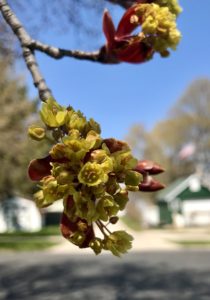 Written by Jessica Johnsrud, Education Coordinator
Written by Jessica Johnsrud, Education Coordinator
After the gray of winter, the bright shades of green plants bursting through the soil is a welcome sight. Pops of purple, yellow and white flowers certainly catch the eye. We notice crocus, daffodils and tulips blooming in our gardens. In the preserve, marsh marigolds, trilliums, violets and many other wildflowers have started to emerge. Many trees are also in bloom in the spring and their flowers are actually quite beautiful.
Currently, the red maples in my neighborhood are in bloom. In the spring, they produce tight buds that appear in clusters. As the temperature warms up, the buds swell and expose the blossoms inside. For a brief period of time, the trees are delicately flowered with red pom pom-like blooms before the leaves unfurl.
Upon careful inspection, you may notice that the flowers look different from tree to tree or even from branch to branch on the same individual. Red maple trees are capable of producing all female flowers or all male flowers, a condition known as monoecious. However, a single tree can produce both male and female flowers and this is known as dioecious. I read that under the “proper conditions”, a red maple can sometimes switch from all male to all female flowers (and vice versa) and even from all male or all female flowers to having both flowers on the same tree. Red maples first bloom when they are about 8 years old, though that can vary greatly.
The male flowers have long stamens that stretch beyond the petals. The tips of the stamens are covered in pollen. The female flowers have a stigma that extends past the petals and this has a sticky tip in order to catch the pollen from the male flowers. This is essential for pollination to occur. Red maples are mostly pollinated by the wind, but are also pollinated by native mason bees and other insects.
Once pollination has occurred, the fertilized maple flowers will produce seeds called samaras. These are winged seeds commonly known as helicopters or whirlybirds because the wing makes them spin when they fall from the tree. The samaras are dispersed by the wind or by animals such as squirrels and will grow into new maple trees if conditions allow.
When the first leaves of the red maple unfurl, they are tiny and bright crimson. Eventually they grow larger, to almost 4 inches in length, and turn green.
Many other trees are also in bloom including: paper birch, serviceberry, ash and black cherry. Each tree’s flowers reveal dainty blooms, some surprisingly fragrant. Don’t forget to look up to enjoy these easily forgotten blooms.
